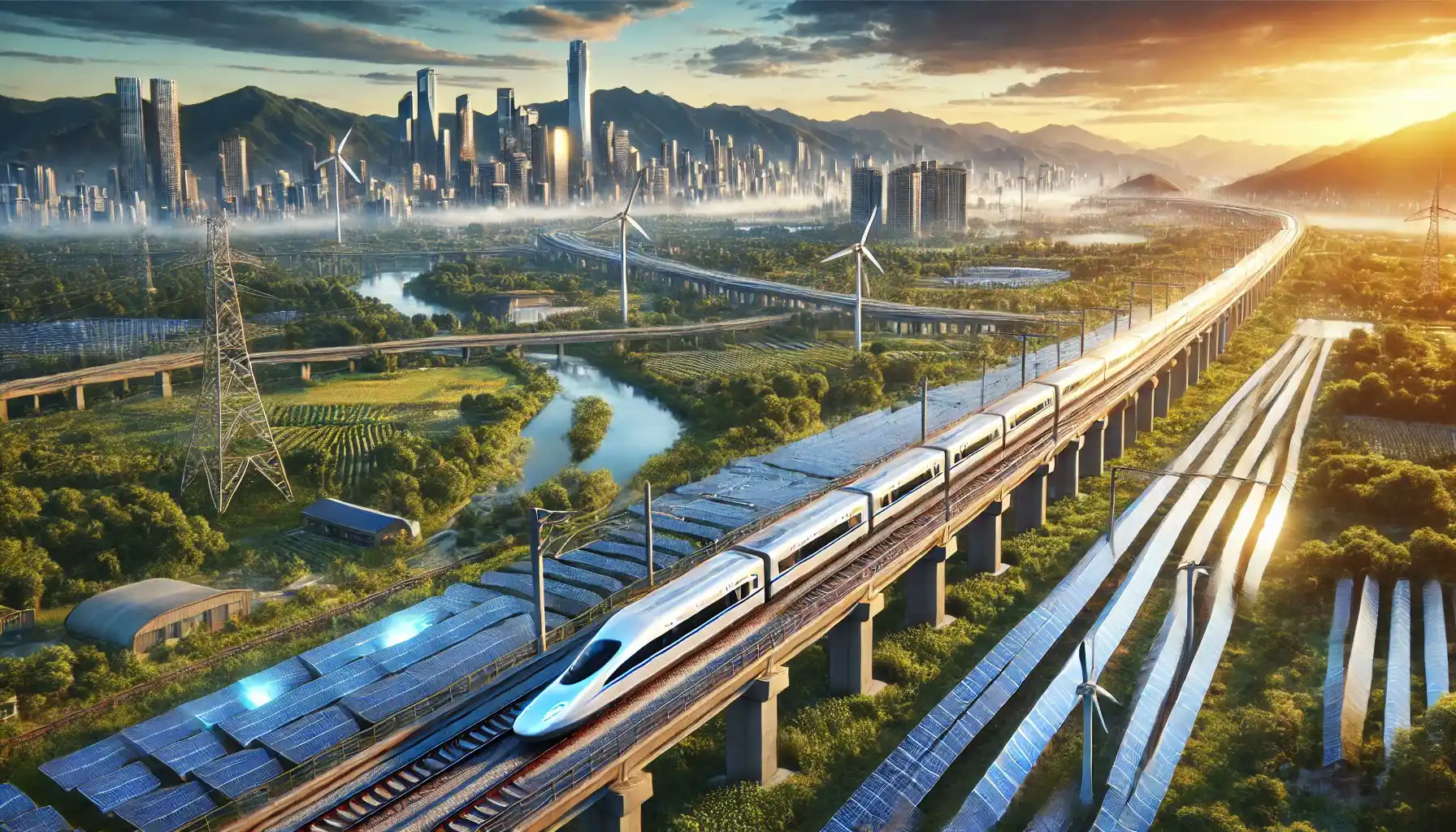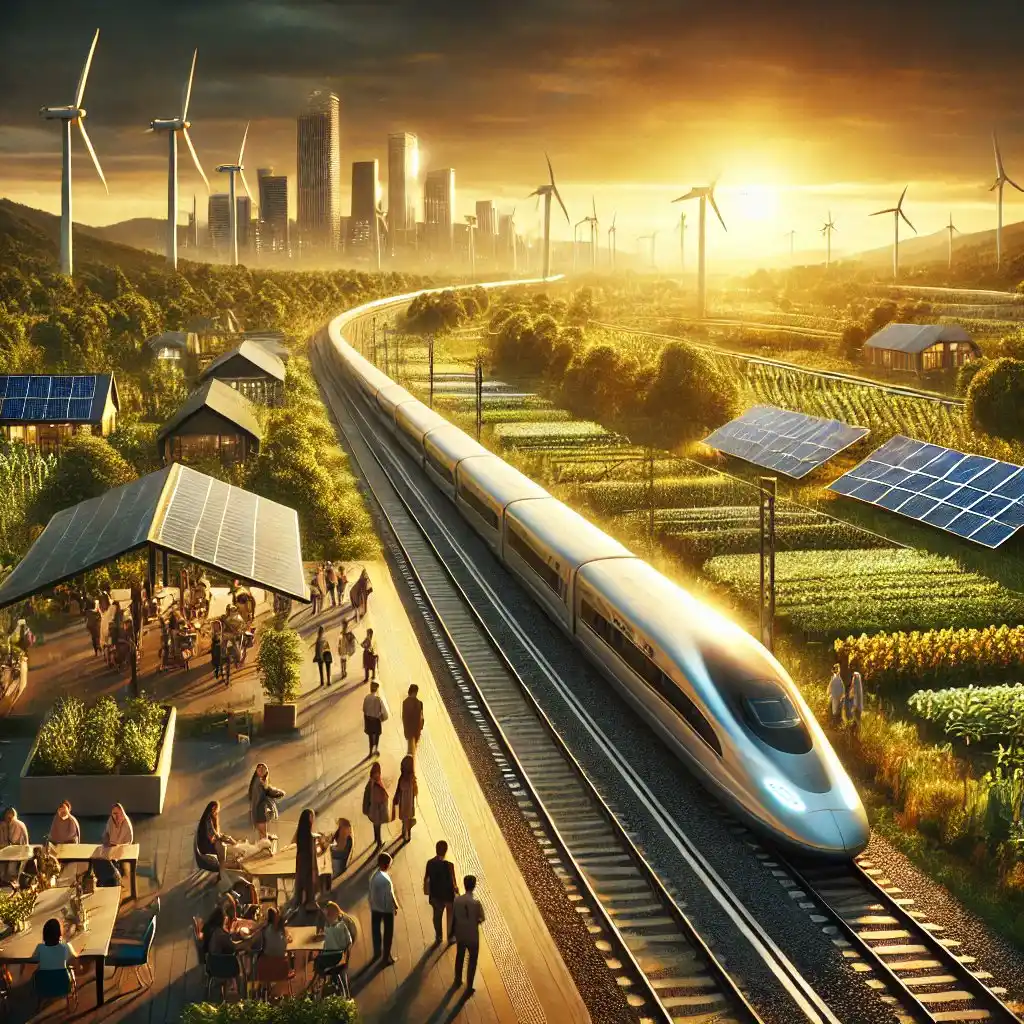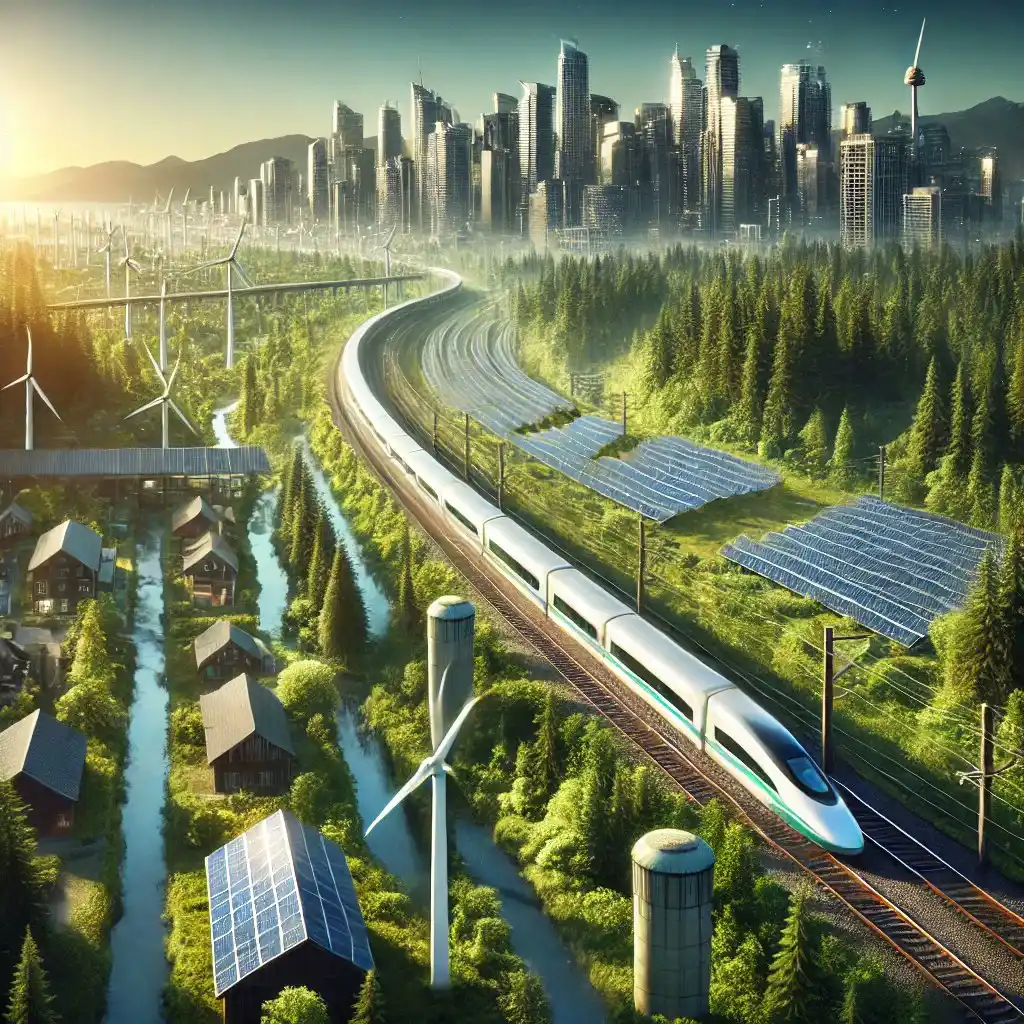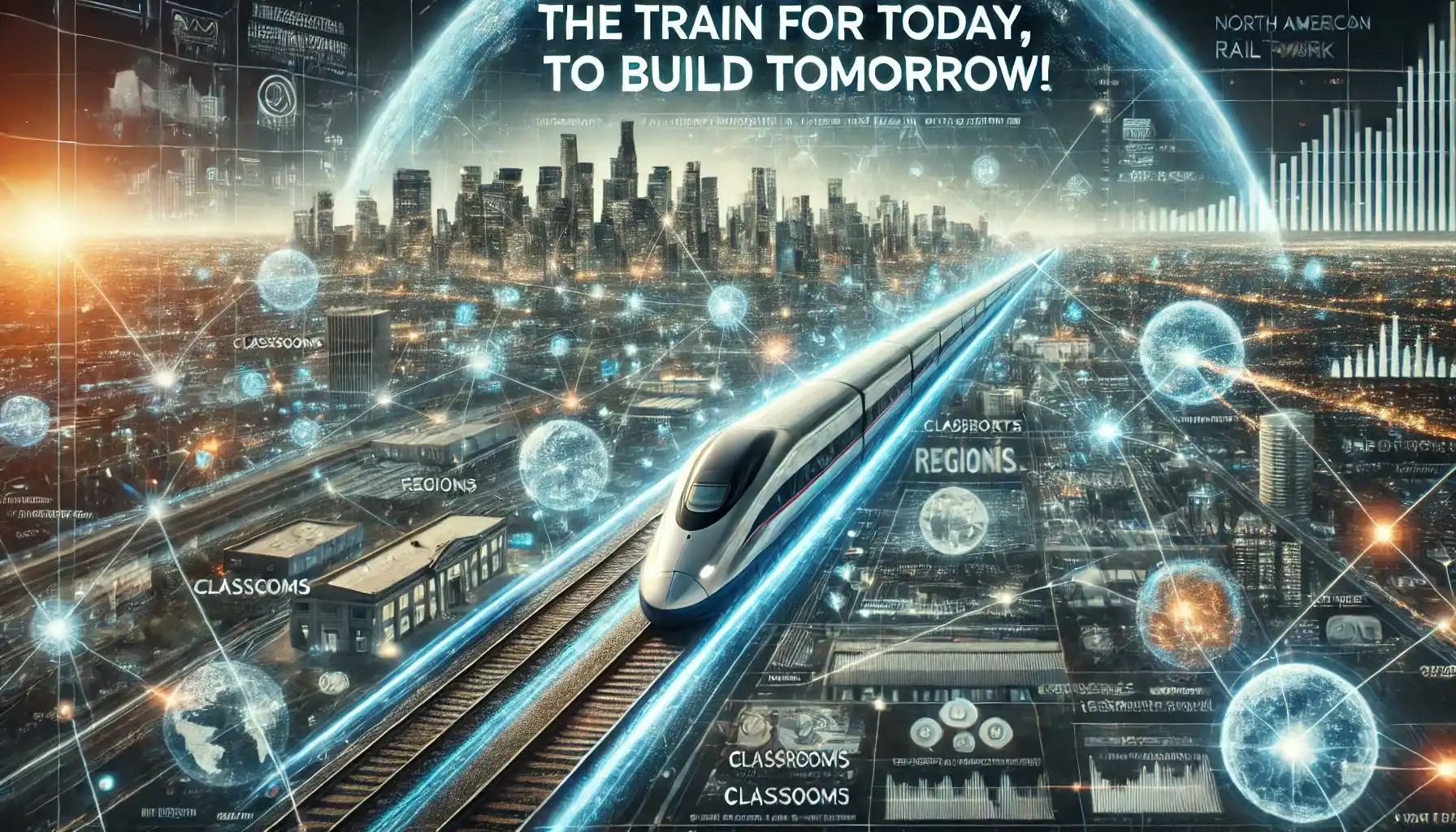1. Executive Summary
This report presents a visionary proposal for a “T-shaped” high-speed rail network designed to transform North America’s transportation infrastructure by connecting Canada and the United States. The proposed network aims to generate unprecedented economic, social, technological, and environmental benefits, positioning North America as a global leader in sustainable and integrated infrastructure.
The TAP-IT Network — short for Transport, Access, Progress, Innovation, Together — has the potential to amplify GDP through the network effect, a phenomenon where the value of a system grows exponentially with increased connectivity.
By linking key economic hubs, the network enables seamless movement of goods, people, and ideas, driving productivity and innovation across industries. Historical precedents, such as Japan’s Shinkansen and China’s high-speed rail system, illustrate the trans-formative power of such infrastructure, and this project seeks to bring similar advancements to North America.
Strategically, the network is designed to integrate resources, energy, academic, technology, and manufacturing hubs across the continent. The horizontal line connects Canada’s major cities, from Vancouver to Halifax, fostering domestic economic integration and enhancing labour mobility (highest velocity is required on this portion due to larger distances between the trips).
The vertical line extends southward through the United States, linking Vancouver and Edmonton with innovation centres like Seattle, Silicon Valley, Austin, and Florida’s aerospace corridor. This design prioritizes high-impact economic zones, connecting them to global markets and enhancing collaboration between industries such as resources, energy, academia, tech, advanced manufacturing and ports.
Beyond its economic promise, the project prioritizes sustainability and cultural mobility. High-speed rail significantly reduces carbon emissions compared to air and automobile travel, contributing to North America’s climate goals. Additionally, by fostering development along rail corridors, the network addresses urban congestion, provides affordable housing opportunities, and revitalizes smaller communities.
This high-speed rail network represents a once-in-a-generation opportunity to reshape North America’s infrastructure, ushering in a new era of connectivity, innovation, and shared prosperity (the North American Economic Miracle). Its implementation will require collaboration among governments, private industries, and communities, but its potential to redefine the continent’s economic and cultural landscape is unparalleled.

2. Introduction
2.1. A Missed Opportunity for Progress
Over the past three decades, Canada has witnessed a stagnation in infrastructure development, particularly in its transportation sector. While countries like China, Japan, and France have revolutionized their economies with the implementation of extensive high-speed rail networks, Canada’s investments in rail have remained modest and limited to incremental improvements. For instance, China has constructed over 42,000 kilometers of high-speed rail since the early 2000s, connecting its vast urban and industrial hubs in ways that have catalyzed economic growth, reduced regional inequalities, and cut carbon emissions. Similarly, Japan’s Shinkansen, operational since 1964, has contributed to decades of consistent economic growth, while France’s TGV has set benchmarks for speed, efficiency, and regional connectivity in Europe.
In contrast, Canada has largely failed to capitalize on similar advancements. Its vast geography and dispersed population centers have exacerbated existing challenges, such as long travel times, over-reliance on air and road transportation, and inefficient freight logistics. While countries with comparable geographic challenges have overcome such barriers with bold infrastructure investments, Canada’s development has been slow and fragmented.
2.2. The Current Challenges
Canada’s lack of modern rail infrastructure has contributed to a host of economic and social challenges:
-
Economic Inefficiencies and Regional Disparities: The absence of fast, reliable transportation networks has hindered the movement of goods and labour between regions. This has left smaller cities isolated, unable to fully participate in national and global markets.
-
Rising Housing Costs and Urban Congestion: The concentration of economic activity in a few urban centers has driven housing prices to unsustainable levels and led to congestion that reduces productivity and quality of life. Without access to efficient transport, people are often forced to live far from job opportunities, increasing commute times and exacerbating urban sprawl.
-
Limited Mobility and Connectivity: Vast regions of Canada remain disconnected, lacking the infrastructure necessary to link major cities efficiently. This limits economic exchange, cultural interaction, and access to essential services.
2.3. A Vision for Transformation
To address these challenges and unlock its full economic potential, North America needs a bold solution: a T-shaped high-speed rail network connecting Canada’s major cities and extending southward through the United States. This trans-formative project envisions an infrastructure that fosters innovation, reduces disparities, and sets a global standard for sustainability and connectivity.
The proposed network will integrate economic, academic, industrial, resource, energy, technological, and manufacturing hubs across both nations, enabling seamless movement of goods, ideas, and people. High-speed rail will reduce travel times dramatically, making intercity commutes viable while alleviating pressure on housing markets in overburdened urban centers. Moreover, by replacing carbon-intensive modes of travel, the network will contribute significantly to environmental goals, positioning North America as a leader in sustainable development, and setting the foundation for an efficient and fast public transport system, that can later be complemented by a fleet of EV buses, Ultra Light Weight Hybrid Electric Natural Gas Buses (CNG Buses), and even hydrogen buses.
This vision extends beyond transportation — it is a blueprint for economic revitalization, cultural exchange, and regional equity.By building this trans-formative infrastructure, Canada and the United States have the opportunity to redefine the future of their economies, empowering citizens with unprecedented connectivity and creating a legacy of innovation and progress.
2.4. Objectives of the High-Speed Rail Network
The TAP-IT High-Speed Rail Network is not merely a transportation initiative— it is a trans-formative infrastructure project designed to address some of the most pressing economic, social, and environmental challenges across North America. Its objectives align with creating a future-ready economy (Industry 4.0), promoting regional advancement, and ensuring sustainable growth.
2.5. Economic Growth through the Network Effect
At the core of the project is the principle of the network effect, where the value of connectivity increases exponentially as more nodes — cities and industries — are integrated.
The high-speed rail network will catalyze GDP growth by dramatically reducing travel and freight transport times, enabling industries to operate with greater efficiency and reach broader markets. Drawing parallels from digital platforms like Facebook or Google, which thrive on inter-connectedness, this rail network will amplify productivity in sectors ranging from manufacturing to tourism, robotics to web applications, aerospace to artificial intelligence, and so forth.
Studies from high-speed rail systems in China have demonstrated that well-integrated rail networks can boost regional GDP by up to 10 – 15%, underscoring the economic potential of this initiative. While 10-15% might appear incremental, the trans-formative effect lies in the network effect, multiplying productivity, trade, and innovation across interconnected hubs.
In global case studies like Japan and China, GDP increases are just the tip of the iceberg — regional equity, innovation ecosystems, and societal transformations ripple outward. TAP-IT doesn’t just move people — it mobilizes economies, talents, and resources on a continental scale.
2.6. Regional Integration for Economic and Cultural Connectivity
The TAP-IT network will physically link economic and cultural hubs across Canada and the United States, bridging geographic barriers and fostering collaboration. By connecting at very high speeds the resource-rich and energy-rich provinces like Alberta with powerhouses like Washington, Oregon, California, Arizona, Texas & Florida, the network will facilitate trade, technology, innovation, and cultural exchange on an unprecedented scale.
‘The key to the 21st century foundation is mobility and speed, and on top of that manufacturing, robotics, blockchain and artificial intelligence.’
Cities like Edmonton, Calgary, Austin, and Miami will benefit from enhanced access to global markets, while smaller towns along the rail corridors will experience newfound economic opportunities, transforming them into vibrant hubs of activity.
2.7. Sustainability and Renewable Energy Integration
Transportation is one of the largest contributors to greenhouse gas emissions globally, accounting for roughly 29% of emissions in the United States alone. The TAP-IT rail network addresses this by providing a low-carbon alternative to air and car travel. High-speed trains, powered by renewable energy sources such as solar and wind, will reduce emissions per passenger-kilo-meter by up to 90% compared to air travel. Moreover, by integrating renewable energy generation along rail corridors, the project ensures not only operational sustainability but also a positive contribution to North America’s clean energy transition.
2.8. Social Equity and Affordable Mobility
The TAP-IT vision represents a trans-formative approach to city development, offering affordable ticket prices and reliable access to under-served regions. By connecting big and small cities along the same rail lines, this network creates the opportunity for the small cities areas to grow into fully developed, vibrant urban centers…
This decentralized growth strategy prevents the unchecked expansion of major cities into inefficient, congested, and crime-ridden mega-cities with insufficient infrastructure, local services, and without sufficient natural support systems along its circumference or perimeter at the point of land access to rural land. (Think dystopian, overpopulated, under resourced, and ultra dense, mega-city depicted in Science Fiction films like Judge Dredd or Dredd.) These type of cities are forecast, in best selling textbooks, to fail from infrastructure collapse by 2044 or by2050.
Instead of a few overburdened “mega city sized urban hubs“ struggling to accommodate ever-growing populations, the TAP-IT network facilitates the “development of a diverse array of thriving cities”, including the “expansion of small cities and the creation of entirely new ones along the high speed rail track in between major cities”. These interconnected cities will have greater surface area exposure to surrounding rural land, thanks to lower population densities. This shift allows for more family-oriented housing communities to emerge in these new cities, as opposed to the dense urban condo developments typically seen in the cores of mature, larger cities. This approach provides ample space and resources for sustainable development, resilient development (one where people can have greenhouses to withstand the 21st century shocks), diversified housing options, and the flourishing of local economies.
By facilitating the movement of people and goods efficiently between these newly thriving cities and established economic centers, the network ensures that population growth is more evenly distributed. This alleviates housing affordability crises, reduces strain on urban infrastructure, and enhances access to rural areas, where individuals and families can enjoy a higher quality of life without sacrificing economic opportunity. The TAP-IT vision thus ushers in a new era of balanced, inclusive, and sustainable urban development.
2.9. Innovation and Workforce Mobility
In a rapidly evolving global economy, the ability to move ideas, talent, and resources efficiently is paramount. The TAP-IT network will serve as the backbone for workforce mobility across North America, allowing skilled workers to access opportunities in cities previously out of reach. Innovation hubs like Silicon Valley, Austin, and Vancouver will benefit from easier collaboration, leading to breakthroughs in technology, manufacturing, and sustainability. Lessons from Japan’s Shinkansen show that enhanced mobility between urban centers drives innovation, and this project aims to replicate those successes on a continental scale.
The objectives of the TAP-IT network are ambitious yet attainable. By focusing on growth, integration, sustainability, resilience, tech advancement, industrial development, manufacturing, resource transport, energy transport, manufacturing, and innovation, the project not only redefines transportation but also serves as a blueprint for North America’s future economic and social success.

3. Proposed Network Design
The TAP-IT High-Speed Rail Network is envisioned as a trans-formative infrastructure project, taking the shape of a T to integrate Canada’s and the United States’ most dynamic economic regions.
The network has been designed to maximize both domestic and cross-border connectivity, with a horizontal East-West axis traversing Canada and a vertical North-South axis extending from Canada into the United States, ultimately reaching Florida’s vibrant economic hubs.
3.1. Horizontal Line (East-West Across Canada)
The horizontal line spans Canada’s primary economic centers, connecting cities from Vancouver on the Pacific Coast to Halifax on the Atlantic Coast.
Proposed Route: (***Victoria) → Vancouver → Calgary → Edmonton → Toronto → Ottawa → Montreal → Quebec City → Halifax.
This route is designed to integrate Canada’s key population and economic zones, fostering domestic trade, labour mobility, and cultural exchange. By linking energy centers in Alberta, industrial hubs in Ontario, and knowledge economies in Quebec, the horizontal line ensures a robust, interconnected national economy. Smaller cities along the route, like Red Deer, stand to benefit significantly, transforming into economic nodes in their own right, while the rail’s presence can also unlock new housing opportunities in underutilized areas.
3.2. Vertical Line (North-South Across North America)
The vertical line extends from Vancouver and Edmonton, seamlessly crossing the U.S. border to integrate North America’s leading innovation hubs and manufacturing centers.
This North-South axis facilitates direct connections between Canada’s energy and technology sectors and the U.S.’s most dynamic economic regions. Vancouver’s tech hub and Alberta’s energy resources are directly linked to the U.S. West Coast’s vibrant innovation ecosystem, including Silicon Valley in San Francisco and Hollywood’s entertainment powerhouse in Los Angeles. Extending further south, the line connects to Phoenix’s growing tech sector, Austin’s thriving startup ecosystem, and finally to Starbase, Texas, a nexus for space exploration and advanced aerospace industries.
The vertical line could be extended eastward from Texas, creating a Y-shaped network that includes key cities in Florida, enhancing North-South connectivity and unlocking even greater economic collaboration across the U.S.
Proposed Florida Route: Austin → Orlando → Tampa → Miami.
This extension strategically targets Florida’s major economic centers:
-
Orlando, home to a burgeoning technology and aerospace sector, and located near the Kennedy Space Center.
-
Tampa, a hub for healthcare, finance, and emerging technologies.
-
Miami, an international trade gateway to Latin America and a cultural and economic powerhouse.
By connecting Texas’s innovation and manufacturing industries with Florida’s technology and global trade networks, the Y-shaped extension transforms the high-speed rail system into a continental economic catalyst.
3.3. Integration with Existing Transport Systems
The TAP-IT network’s success depends on its ability to seamlessly integrate with North America’s broader transportation ecosystem:
-
Commuter and Regional Rail: High-speed stations will connect to local transit systems, enabling passengers to complete their journeys efficiently.
-
Airports: Key rail hubs will be strategically located near major airports, providing multi-modal transport options for travellers.
-
Freight Logistics: Incorporating dual-use tracks for freight will enhance supply chain efficiency, enabling rapid movement of goods between production centers and markets.
3.4. Transformative Potential
The TAP-IT high-speed rail network represents a paradigm shift in North American transportation. By connecting Canada’s economic hubs with the U.S.’s centers of innovation and global trade, the network fosters unparalleled economic collaboration, labour mobility, and cultural exchange. Its seamless integration with existing systems and its strategic alignment with regional industries ensure that the network not only serves as a transportation solution but also as a driver of continental prosperity.

4. Economic Impact
The proposed TAP-IT High-Speed Rail Network has the potential to redefine North America’s economic landscape, driving unprecedented growth, reducing disparities, and unlocking new opportunities across the continent. Its trans-formative power lies in its ability to amplify GDP through the network effect, stimulate regional development, and create millions of jobs in the short and long term.
4.1. Amplifying GDP Through the Network Effect
At the heart of the network’s economic impact is the network effect, a phenomenon where each additional connection within a system exponentially increases its overall value. High-speed rail achieves this by seamlessly linking production hubs, labour pools, and consumer markets. This integration fosters the rapid exchange of goods, services, and ideas, catalyzing growth across industries such as manufacturing, technology, logistics, and tourism.
The concept is analogous to the success of digital platforms like Facebook, Google, and Bitcoin, where interconnected systems drive value creation. For instance, case studies from Japan’s Shinkansen and France’s TGV demonstrate that high-speed rail can increase regional GDP by 10-15% by boosting labor productivity, reducing travel times, and enhancing supply chain efficiency. Similarly, China’s 42,000-kilometer high-speed rail network, completed over two decades, has been instrumental in integrating its industrial hubs, reducing regional economic disparities, and enabling sustained economic growth.
4.2. Stimulating Regional Development
One of the most significant advantages of the TAP-IT network is its capacity to revitalize smaller cities and underutilized regions. Cities like Red Deer, Alberta, which currently lack significant connectivity, will be transformed into thriving urban hubs through strategic station placements and integrated infrastructure planning. High-speed rail stations have historically acted as magnets for development, attracting businesses, residential projects, and cultural activities.
Moreover, the development of rail corridors will open up opportunities for affordable housing, addressing urban housing shortages by enabling people to live in less dense areas while commuting quickly to larger economic centers. This planned urbanization, inspired by successful rail models in Japan and Europe, fosters balanced regional growth and reduces the strain on metropolitan areas.
4.3. Job Creation
-
Short-Term Impact: The initial phases of the project, including feasibility studies, environmental assessments, and construction, will create millions of jobs in fields such as engineering, architecture, construction, and manufacturing. These roles will demand a wide range of skill levels, providing employment opportunities across diverse sectors.
-
Long-Term Impact: Once operational, the network will generate sustained employment in industries such as transportation, logistics, and tourism. Additionally, the economic activity spurred by the network — such as the expansion of businesses, new real estate developments, and increased tourism — will create ancillary jobs, ensuring long-term economic vitality.
4.4. Case Studies of Economic Success
-
Japan’s Shinkansen: The bullet train network has contributed significantly to Japan’s economic growth by connecting regional cities to Tokyo, fostering labour mobility, and enhancing access to markets.
-
France’s TGV: High-speed rail has spurred regional development, enabling smaller cities to compete economically with Paris by reducing travel times and enhancing trade.
-
China’s High-Speed Rail: The world’s largest high-speed rail network has bridged regional disparities, enabling the development of industrial hubs in previously underdeveloped areas.
4.5. Conclusion
The economic impact of the TAP-IT High-Speed Rail Network extends beyond the immediate benefits of faster transportation. By amplifying GDP through enhanced connectivity, fostering balanced regional development, and creating jobs at an unprecedented scale, the project promises to unlock North America’s full economic potential. This initiative represents a bold step toward a more integrated, productive, and equitable future.

5. Technical Considerations
The successful implementation of the TAP-IT High-Speed Rail Network hinges on addressing a range of technical considerations. From infrastructure design to energy requirements, each aspect of the project must be optimized for efficiency, safety, and sustainability. Leveraging the latest advancements in technology and engineering, this network aims to set a benchmark for modern transportation systems.
5.1. Infrastructure Requirements
One of the foundational decisions for the network involves selecting the appropriate track design. Standard gauge tracks are widely used globally and offer compatibility with existing rail systems, while maglev (magnetic levitation) technology promises unparalleled speed and operational efficiency by reducing friction. The choice between these systems will depend on factors such as cost, terrain, and desired speed capabilities.
Station placement is equally critical to the network’s success. Stations must be strategically located to balance urban and rural accessibility, ensuring that economic benefits extend to under-served areas. Major hubs like Vancouver, Toronto, and Austin will anchor the network, while intermediate stops in smaller cities, such as Red Deer or Tampa, will foster regional development and economic integration.
5.2. Energy Needs
Achieving sustainability requires integrating renewable energy sources into the network’s operations. High-speed trains can be powered by solar, wind, and hydroelectric energy, significantly reducing their carbon footprint compared to traditional transportation modes. For instance, the Japanese Shinkansen achieves impressive energy efficiency, emitting approximately 90% less CO₂ per passenger-kilometer than air travel.
To ensure reliability, the network will explore energy storage solutions, such as advanced battery systems and hydrogen fuel cells, which can store surplus energy generated during peak renewable production periods. These technologies will enhance resilience and operational consistency, even during fluctuating energy demand.
5.3. Engineering Challenges
North America’s diverse geography presents unique engineering challenges for the TAP-IT network. The system must traverse mountain ranges, rivers, and deserts, requiring innovative solutions such as tunnels, bridges, and elevated tracks. For example, the Rocky Mountains between Vancouver and Calgary will necessitate precise funnelling and viaduct construction, akin to projects in Switzerland and Japan.
The network must also incorporate climate-resilient designs to withstand extreme weather conditions. Elevated tracks, reinforced bridges, and advanced drainage systems will mitigate risks from flooding, wildfires, and other natural disasters, ensuring operational continuity and passenger safety.
5.4. Smart Rail Systems
The TAP-IT network will leverage AI and IoT technologies to create a smart, adaptive transportation system. AI-driven predictive analytics will optimize scheduling, minimizing delays and maximizing efficiency. Sensors embedded in tracks and trains will enable real-time monitoring of infrastructure and equipment, allowing for proactive maintenance and reducing costly disruptions.
IoT-enabled devices will enhance the passenger experience, providing real-time updates on train schedules, seat availability, and onboard services. These technologies have been successfully implemented in European systems like the Deutsche Bahn, demonstrating their potential to revolutionize rail operations.
5.5. Safety and Cybersecurity
Safety is paramount in any high-speed rail system. The TAP-IT network will integrate cutting-edge safety protocols, including automated braking systems, collision detection, and advanced emergency response mechanisms. These measures will draw from global best practices, such as those implemented in the TGV and Shinkansen networks, which boast near-perfect safety records.
Cyber-security will be another critical focus, as the reliance on smart systems increases vulnerability to potential cyber-attacks. Robust encryption, intrusion detection systems, and real-time threat monitoring will protect operational systems and passenger data. Partnerships with leading cyber-security firms will ensure that the network adheres to the highest standards of digital security.

5.6. Conclusion
The technical considerations for the TAP-IT High-Speed Rail Network reflect the complexities and opportunities of building a 21st-century transportation system. By addressing infrastructure design, energy needs, engineering challenges, smart technologies, and safety protocols, the network will set a new standard for efficiency, sustainability, and innovation. These considerations form the backbone of a project poised to transform North America’s mobility and economic landscape.

6. Environmental and Social Benefits
The TAP-IT High-Speed Rail Network is not just a trans-formative transportation project; it is a critical investment in addressing environmental challenges, setting the foundation to build the next generation reality for North America, and with the enhanced performance provided to the nation, to the world. By fostering a sustainable, accessible, professional and inclusive approach to infrastructure development, the network will leave a lasting positive impact on the environment and society.
6.1. Carbon Emission Reductions
Transportation accounts for a significant share of greenhouse gas emissions, with road vehicles and air travel among the leading contributors. High-speed rail offers a more sustainable alternative, reducing emissions by as much as 90% per passenger-kilo-meter compared to air travel and 75% compared to cars, as demonstrated by existing networks like Japan’s Shinkansen and Europe’s TGV.
The TAP-IT network will further accelerate the transition to a low-carbon future by encouraging the shift from high-emission travel modes to rail. It will establish benchmarks for achieving net-zero carbon emissions, incorporating renewable energy sources such as solar, wind, and hydroelectric power into its operations. The reduction in long-haul car travel and domestic flights will have a measurable impact on national carbon footprints, positioning North America as a leader in green infrastructure development.
6.2. Urban Decentralization
The high-speed rail network will play a pivotal role in re-balancing population density and development across North America. Overpopulated cities like Toronto, Vancouver, and Los Angeles face increasing pressure on housing, infrastructure, and public services. By creating fast, reliable links to smaller cities and rural areas, the rail network will encourage the growth of new communities along its corridors.
These communities will benefit from planned urbanization, supported by mixed-use developments near rail stations that integrate residential, commercial, and recreational spaces. This model, inspired by transit-oriented developments in cities like Tokyo and Paris, ensures that economic opportunities are accessible while minimizing environmental impact.
For example, a mid-sized city like Red Deer in Alberta could transform into a thriving hub of economic activity, attracting businesses and residents seeking affordable alternatives to Calgary or Edmonton. This balanced regional development will reduce the strain on major metropolitan areas while fostering vibrant new urban centers.
6.3. Equity and Accessibility
One of the TAP-IT network’s defining goals is to promote equitable access to transportation. By offering affordable ticket pricing, the network will ensure that rail travel is accessible to people of all income levels, making it a viable alternative to driving or flying. Advanced pricing models, including subsidies for low-income travellers, subsidies for job applicants/career candidates, and discounts for frequent riders, will encourage widespread adoption.
Accessibility will also extend to physical infrastructure, with stations and trains designed to accommodate people with disabilities. Features such as step-free access, tactile pathways, and dedicated seating areas will ensure that the network adheres to the highest standards of universal design.
The planning and development process will actively involve Indigenous communities, ensuring that their voices are heard and their interests represented. Joint ventures and community benefit agreements will provide opportunities for economic participation, skill development, and cultural preservation. This inclusive approach will strengthen relationships and create shared prosperity across regions.
6.4. Conclusion
By addressing critical environmental and social challenges, the TAP-IT High-Speed Rail Network represents a holistic approach to infrastructure development. Through significant reductions in carbon emissions, the promotion of balanced urban growth, and the provision of equitable access, the network will enhance the quality of life for millions while contributing to a more sustainable and inclusive North America. This project is not only an investment in mobility but a commitment to building a greener, fairer, faster, advanced, industrially capable, tech capable and productive future for generations to come.

7. Implementation Strategy
The successful implementation of a T-shaped high-speed rail network connecting North America’s economic and cultural hubs requires a phased and collaborative approach, underpinned by sound policy frameworks and strategic investments. The strategy ensures that the project is both technically viable and socially inclusive, maximizing benefits while mitigating risks.
7.1. Phased Rollout: A Measured Approach
The implementation will begin with rigorous feasibility studies to establish technical, economic, and environmental viability. These studies will engage stakeholders from multiple sectors, including government, private industries, and local communities, to address concerns and align objectives.
7.2. Feasibility Studies and Preliminary Assessments
Feasibility studies will evaluate potential routes, cost structures, and environmental impacts. Key considerations include terrain analysis, population density, and economic activity along proposed corridors. Environmental assessments will ensure compliance with climate commitments, especially concerning carbon neutrality and biodiversity conservation.
7.3. Foundation for High-Impact Corridors
Initial foundation projects will focus on routes with the highest potential for economic and social return. For example:
-
Connects two powerhouse states with robust economies.
-
Links Texas’s tech and energy hubs to California’s innovation and entertainment industries.
-
Ideal for testing high-speed rail’s ability to reduce reliance on air travel in a high-demand region.
-
Route: Austin → Houston → New Orleans → Orlando → Tampa → Miami
-
Combines Texas’s innovation and energy sectors with Florida’s aerospace, tourism, and global trade markets.
-
Focuses on regions with growing populations and significant commuter congestion.
-
Spurs development along the Gulf Coast and connects key hubs for cultural and economic collaboration.
7.4. Full Deployment
Lessons learned from pilot projects will inform the expansion across the proposed T-shaped network. The rollout will integrate advanced engineering solutions to address regional challenges, including climate resilience and cross-border interoperability. Strategic scaling will prioritize high-traffic and under-served areas, ensuring equitable access.
7.5. Collaboration: Building a Strong Coalition
7.6. Policy Recommendations: Paving the Way
To facilitate efficient implementation, policy reforms must address regulatory and financial hurdles:
Regulatory Streamlining: A unified regulatory framework will expedite cross-border operations and approvals. Coordination between Canadian and U.S. agencies will simplify customs and immigration processes for seamless passenger and freight movement.
Tax Incentives:Incentives for private investors and sustainable construction practices will attract capital and ensure adherence to environmental standards. Tax credits for renewable energy adoption and local workforce development will further enhance project sustainability.
Public-Private Partnerships (PPPs): PPPs will distribute risks and benefits between public entities and private stakeholders. This model leverages private-sector innovation and efficiency while ensuring public accountability.
7.7. A Roadmap for Transformation
The phased rollout, combined with multi-sector collaboration and progressive policies, provides a clear pathway for realizing the TAP-IT vision. The strategy will balance technical feasibility with social and environmental considerations, ensuring that the high-speed rail network becomes a model of sustainable, inclusive infrastructure development. By fostering regional connectivity and economic growth, this implementation plan will transform North America’s transport landscape, setting a global precedent for innovation and collaboration.

8. Comparative Insights: Lessons from Global High-Speed Rail Successes
The success stories of high-speed rail systems in China, Europe, and Japan provide invaluable lessons for North America’s proposed “T-shaped“ and “Y-shaped” high-speed rail network. Each of these regions showcases how robust planning, strategic investment, and bold infrastructure initiatives can reshape economies, reduce disparities, and transform mobility.
8.1. China: The 42,000-Kilometer Revolution
In just 16 years, China has constructed the world’s most extensive high-speed rail network, spanning over 42,000 kilometers. This feat, accomplished through a combination of state-backed funding, cutting-edge technology, and rigorous planning, and sufficient human resources at job site instead of at home in the millions, serves as a benchmark for large-scale infrastructure projects.
China’s high-speed rail has transformed domestic mobility, connecting previously isolated cities, regions and critically; manufacturing and technology centres. Economic gains have been profound: the network has contributed to a 2.4% annual increase in GDP, with secondary cities like Wuhan and Zhengzhou emerging as major economic hubs.
The country’s model of integrating high-speed rail with urban planning — such as station-adjacent business districts — demonstrates how rail infrastructure can amplify both regional development and national economic growth.
8.2. Europe: The Economic Unifier of France
The French TGV (Train à Grande Vitesse) system, operational since 1981, highlights the power of high-speed rail to integrate regions and spur economic activity. Linking Paris to major cities like Lyon, Marseille, and Lille, the TGV has redefined travel, reducing commute times and fostering inter-generational trade and tourism.
A notable success of the TGV lies in its role as an economic equalizer. Smaller cities along the network have benefited from increased accessibility, attracting investment and talent that might otherwise concentrate in Paris. Additionally, France’s focus on energy efficiency has set a global standard: the TGV operates on electricity sourced from nuclear and renewable energy, offering a blueprint for sustainable rail systems.
8.3 Japan: The Shinkansen and Regional Disparity Reduction
Japan’s Shinkansen, or “bullet train,“ launched in 1964, remains a gold standard in high-speed rail. Stretching across 2,764 kilometers, the Shinkansen not only set speed records but also addressed one of Japan’s core economic challenges: regional disparities.
By connecting rural and urban areas, the Shinkansen enabled balanced economic growth, decentralizing industries from Tokyo and Osaka to smaller cities like Sendai and Fukuoka. The rail system also achieved unmatched safety records, boasting zero passenger fatalities since its inception — a testament to its world-class engineering and operational standards. Furthermore, the Shinkansen has been a key driver in reducing Japan’s carbon footprint, shifting millions of travellers from air and road to rail annually.
8.4. Key Takeaways for North America
North America can learn from these systems by prioritizing comprehensive integration with urban planning, emphasizing sustainability, and ensuring equitable access to economic opportunities, and fusing rural life with urban life with high speed transport solutions (A key AI Safety requirement).
The successes of China, France, and Japan prove that high-speed rail is not just a transportation upgrade but a catalyst for widespread economic and social transformation.
By adopting best practices and tailoring them to the unique challenges of Canada and the United States, the TAP-IT network can redefine North American infrastructure, mobility, and growth.

9. Quotes and Anecdotes: Bringing the Vision to Life
Incorporating personal insights and memorable quotes can humanize the technical and economic rationale behind “TAP-IT,” making the vision of a North American high-speed rail network relatable to stakeholders. These reflections underscore the urgency and trans-formative potential of this project, connecting it to universal values like progress, innovation, and legacy.
One evocative remark that captures the essence of this initiative is, “The train for today, to build tomorrow! Don’t let the train stop moving!” This phrase encapsulates the dynamic momentum of infrastructure-led development.
Just as past generations built railways, highways, and airports that laid the foundation for today’s economies, TAP-IT seeks to invest in a future of enhanced mobility and inter-connectedness.
The metaphor of a“train that must not stop” serves as a call to action, urging stakeholders to recognize that every delay in implementing high-speed rail is a lost opportunity for economic growth and sustainability, and perhaps resilience itself in the face of great resilience, challenge, adversity and danger.
Another perspective likens high-speed rail to modern digital networks, with the statement: “High-speed rail acts as a GDP amplifier — like the networks behind Facebook, Google, and Bitcoin.” This comparison illustrates how infrastructure systems, whether physical or digital, create exponential value when designed for inter-connectivity. High-speed rail, like these digital networks, can multiply productivity by linking talent, resources, and markets across vast distances. This concept, supported by case studies of Japan’s Shinkansen and China’s rail network, shows how seamless connectivity amplifies regional and national economic outputs.
Lastly, a poignant observation reflects on societal priorities: “Classrooms seem less tidy now in 2024 versus in 1991, and less focused on good quality education.” This sentiment underscores the broader societal implications of under-investment in infrastructure and public goods. High-speed rail, much like well-funded schools, represents a commitment to collective progress. Both serve as benchmarks of a society that prioritizes its future by enabling equitable access to opportunities, whether through education or mobility.
These quotes and anecdotes weave together a narrative that is both practical and aspirational. They remind stakeholders of the human impact of infrastructure projects and the collective responsibility to build systems that enhance the lives of current and future generations. By framing high-speed rail as both a practical solution and a symbol of progress, TAP-IT positions itself as an emblem of North America’s readiness to lead in the 21st century.

10. Risk Management
Building a high-speed rail network of this magnitude requires addressing a broad spectrum of risks to ensure long-term success and resilience. From geopolitical complexities to the challenges posed by climate change and cyber threats, the TAP-IT initiative must integrate proactive measures to mitigate potential disruptions.
10.1. Geopolitical Risks
The cross-border nature of the TAP-IT high-speed rail network poses unique geopolitical challenges. Trade restrictions, shifting political landscapes, and opposition from interest groups could jeopardize the project’s timeline and funding. To mitigate these risks, the following measures are crucial:
-
Proactive Diplomacy: Engage in early and continuous dialogue with Canadian and U.S. federal, state, and provincial governments to align on shared economic and environmental benefits. Leveraging international frameworks like the United States-Mexico-Canada Agreement (USMCA) can help facilitate smoother negotiations.
-
Diversified Supply Chains: Develop contingency plans for sourcing materials and technology to reduce dependency on any one country. Diversification ensures resilience against tariffs, export controls, or supply chain disruptions triggered by global tensions.
-
Public Advocacy: Launch an outreach campaign to highlight the project’s benefits to both nations, including job creation, reduced carbon emissions, and enhanced trade connectivity. Transparent communication can preempt political opposition and gain public buy-in.
10.2. Cybersecurity
As the rail network integrates advanced technologies, such as IoT-based monitoring systems and AI-driven operations, cybersecurity becomes paramount. Rail systems worldwide have increasingly become targets for cyberattacks, with potential threats ranging from operational disruptions to passenger safety breaches. The TAP-IT project must adopt state-of-the-art cybersecurity frameworks:
-
Robust Architecture: Design the network’s digital infrastructure with layered defenses, including encryption protocols, secure authentication mechanisms, and firewalls. Regularly update software and hardware to address emerging vulnerabilities.
-
Incident Response Teams: Establish dedicated cybersecurity teams capable of detecting, mitigating, and recovering from potential breaches. A rapid response strategy is essential for minimizing operational downtime and protecting sensitive data.
-
Collaboration with Experts: Partner with cybersecurity firms and national agencies, such as Canada’s CSE and the U.S.’s CISA, to adopt best practices and share threat intelligence.
10.3. Climate Resilience
The rail network’s extensive infrastructure will need to withstand increasingly severe and unpredictable weather events driven by climate change. From hurricanes in the southern United States to ice storms in Canada, climate resilience must be integral to the project’s design and operations:
-
Durable Materials:Use advanced, weather-resistant construction materials capable of enduring extreme conditions such as floods, heat waves, and heavy snow. Elevated tracks in flood-prone areas can further mitigate risks.
-
Smart Monitoring Systems: Deploy IoT-enabled sensors to monitor real-time environmental conditions, such as temperature, wind speeds, and soil stability. These systems can trigger automated responses, such as slowing trains during storms or rerouting traffic.
-
Energy Redundancy: Integrate renewable energy sources like solar panels and wind farms along the rail lines to ensure continuous operations during grid disruptions caused by extreme weather.
10.4. Comprehensive Approach
A multi-layered risk management strategy is essential for the TAP-IT initiative to thrive. The project must not only anticipate risks but also create an adaptive framework capable of evolving with geopolitical shifts, technological advancements, and climate uncertainties. By embedding resilience into its foundations, the high-speed rail network can emerge as a trans-formative and enduring achievement for North America.

11. Conclusion: A Blueprint for North America’s Future
The TAP-IT High-Speed Rail Network represents a trans-formative leap forward for North America, a bold vision to redefine the continent’s infrastructure, economy, and cultural connectivity. By integrating Canada and the United States with a state-of-the-art transportation system, the TAP-IT network has the potential to address long-standing challenges, catalyze economic growth, and create a more sustainable and equitable future.
At its core, the TAP-IT network is more than a transportation initiative — it is a generational investment in progress. Drawing lessons from the unparalleled success of high-speed rail systems in China, Japan, and Europe, the TAP-IT network is poised to become a driver of economic prosperity. The network effect, a proven catalyst for exponential growth, will amplify productivity across industries by connecting economic hubs, fostering collaboration, and unlocking regional potential. Projections based on global precedents estimate billions in annual GDP growth, a significant reduction in regional disparities, and the creation of over a million new jobs in the first decade alone.
Beyond economics, the TAP-IT network addresses urgent environmental and social imperatives. With transportation accounting for nearly 30% of greenhouse gas emissions in North America, high-speed rail offers a sustainable alternative to air and car travel, reducing emissions by up to 90% per passenger-kilometer. By shifting to renewable energy sources and fostering urban decentralization, the network will not only combat climate change but also alleviate housing crises and urban congestion, empowering smaller communities to thrive.
Culturally, the TAP-IT network will redefine connectivity by bridging vast distances and fostering greater integration across North America’s diverse regions. From Red Deer, Alberta, to Miami, Florida, it will bring people closer together, enhancing cultural exchange and creating opportunities for collaboration that were once unimaginable. This infrastructure embodies a commitment to equity, ensuring that rural and under-served areas share in the benefits of enhanced mobility and economic participation.
The realization of this ambitious vision demands collective action. Governments, private industry, and communities must collaborate to overcome technical, financial, and geopolitical challenges. Public-private partnerships, regulatory reforms, and innovative financing mechanisms will be essential to ensure the network’s success. Equally critical is the engagement of citizens and local leaders, whose support will drive the momentum needed to turn this vision into reality.
As the world faces increasing environmental, economic, and societal challenges, the TAP-IT High-Speed Rail Network offers a blueprint for economic growth (high speed rail manufacturing, aerospace manufacturing, robotics manufacturing, semiconductor manufacturing), supply chain security (produce transport, decentralized greenhouse production near cities, arrive by train not truck), resilience, national security (enabling advance and large scale ship building, drone building, aerospace and space systems development), industrial progress, technological progress and the foundational architecture for freedom on Earth, space exploration and multi-planetary life distribution and construction system (better than Amazon… Space Amazon).
It is a bold statement of North America’s readiness to lead in the 21st century, combining the ingenuity of its people with the power of trans-formative infrastructure (with a little help from Japan and South Korea).
‘The time to act is now.’
Stakeholders across all sectors must seize this opportunity to champion a project that promises to redefine North America’s future — one where connectivity, sustainability, and prosperity become the hallmarks of a united continent.
Together, we can ensure that the TAP-IT network not only connects cities but also bridges gaps, elevates communities, and leaves a legacy of innovation and progress for generations to come.

12. Appendices
The appendices provide a comprehensive set of resources and analyses to support the TAP-IT vision for North America’s high-speed rail network. By including detailed manufacturer options, maps, economic projections, case studies, and feasibility assessments, this section ensures a robust foundation for stakeholders, planners, and policymakers to make informed decisions. Below are the key elements of this section:
Appendix: Manufacturer Analysis for High-Speed Rail and Maglev Solutions
This section evaluates the top rail manufacturers suitable for the TAP-IT High-Speed Rail Network. The selection criteria include technical capabilities, speed, sustainability, U.S. and Canadian manufacturing potential, and alignment with the project’s objectives. These manufacturers represent the forefront of high-speed rail and maglev technology, ensuring a sustainable and innovative future for North American transportation.
1. Mitsubishi Heavy Industries (Japan) – Maglev Leader
-
Product: L0 Series SCMaglev
-
Top Speed: 603 km/h (375 mph) (tested); 500 km/h (311 mph) (operational target).
-
Technology: Superconducting Magnetic Levitation (SCMaglev).
-
Specifications: Virtually frictionless motion due to magnetic levitation. Advanced safety systems and earthquake-resistant engineering. Ultra-smooth and quiet operation for enhanced passenger comfort.
-
North American Potential: Mitsubishi can establish U.S.-based production facilities, leveraging partnerships with local firms for component manufacturing and assembly.
-
Case Study: Tokyo-Nagoya line under construction, showcasing real-world scalability of maglev systems.
2. Central Japan Railway Company (JR Central) – High-Speed Maglev Innovator
-
Product: SCMaglev L0 (in partnership with Mitsubishi).
-
Top Speed: 603 km/h (375 mph) (tested); 500 km/h (311 mph) (operational target).
-
Technology: Advanced superconducting magnetic levitation.
-
Specifications: Designed for long-distance travel with unparalleled speeds. Emphasis on safety and climate resilience.
-
North American Presence: Active involvement in the Texas Central project with N700-I Bullet train technology.
3. Hitachi Rail (Japan) – High-Speed Rail Innovator
-
Product: AT400.
-
Top Speed: 360 km/h (224 mph).
-
Specifications: Energy-efficient design with passenger-centric features. Advanced digital signalling and automation for operational efficiency.
-
U.S. Expansion: Building a railcar manufacturing facility in Maryland, capable of expanding production for high-speed rail systems.
4. Siemens Mobility (Germany) – Dual Potential (High-Speed Rail and Maglev)
-
High-Speed Rail Product: Velaro Novo.
-
Top Speed: 360 km/h (224 mph). Specifications: Lightweight, aerodynamic, energy-efficient design with a focus on passenger comfort. U.S. Facility: New York-based plant set for high-speed rail production by 2026.
-
Maglev Potential: Siemens has historical involvement in maglev technology (Transrapid system) and could revive these capabilities in the U.S. with proper investments.
5. Kawasaki Heavy Industries (Japan) – Proven Shinkansen Expertise
-
Product: Shinkansen N700S.
-
Top Speed: 360 km/h (224 mph).
-
Specifications: Aerodynamic design and lightweight construction for energy efficiency. Earthquake-resistant safety measures and operational reliability.
-
U.S. Production: Existing railcar facilities in Nebraska and New York, adaptable for high-speed train assembly.
6. Bombardier Transportation (Canada, now part of Alstom) – Canadian Rail Powerhouse
-
Product: Zefiro 300.
-
Top Speed: 380 km/h (236 mph).
-
Specifications:Focus on high capacity and operational flexibility. Sustainability-centric design with low energy consumption.
-
Canadian Presence: Existing manufacturing plants in Thunder Bay and La Pocatière could be revitalized for high-speed rail projects.
7. Hyundai Rotem (South Korea) – Emerging High-Speed Rail Player
-
Product: HEMU-430X.
-
Top Speed: 430 km/h (267 mph).
-
Specifications: Distributed power systems for efficient operation. Passenger-focused design and safety technologies.
-
U.S. Presence: Active railcar supplier for U.S. transit systems, with assembly facilities ready for scaling high-speed rail production.
Recommendations for TAP-IT Network Implementation
1. Maglev Deployment:
Primary Manufacturer: Begin with Mitsubishi Heavy Industries’ SCMaglev for flagship routes requiring extreme speeds and long distances, such as Vancouver to Calgary or Texas to California.
Mitsubishi’s SCMaglev is the most advanced maglev system globally, offering unparalleled speed, efficiency, and safety.
Collaborate with Siemens to explore a revival of Transrapid-style maglev for mid-range corridors where speeds over 300 km/h are required.
This diversification ensures flexibility across varying regional needs and terrain challenges.
2. High-Speed Rail Expansion:
Utilize Hitachi, Bombardier (Alstom), and Kawasaki for versatile high-speed rail systems tailored to shorter, high-demand corridors, such as Toronto-Montreal or Texas-Florida.
These systems offer proven reliability and sustainability for regional travel.
Leverage Local Manufacturing: Ensure all selected high-speed rail manufacturers establish or expand U.S. and Canadian production facilities to meet “Made in North America” requirements and create regional economic opportunities.
3. Collaborative Partnerships:
Essential Requirement: Foreign manufacturers must commit to setting up or expanding domestic manufacturing facilities in North America as part of the procurement process.
Foster technology transfer agreements to build long-term domestic expertise in maglev and high-speed rail manufacturing, ensuring a resilient supply chain and local innovation capacity.
4. Sustainability and Innovation:
Mandate renewable energy integration for powering rail systems, using solar, wind, and hydroelectric sources.
Incorporate AI-driven automation and smart infrastructure for optimized scheduling, predictive maintenance, and enhanced passenger safety.
12. Why Mitsubishi Heavy Industries?
-
Unmatched Speed: Tested at 603 km/h (375 mph), operational target of 500 km/h (311 mph).
-
Technological Leadership: Superconducting magnetic levitation minimizes friction and wear, enabling extreme speeds with high energy efficiency. (especially beneficial to boosting economic activity and high velocity productivity in Canada).
-
Safety and Resilience: Advanced earthquake-resistant designs make it uniquely suited for North American conditions.
-
Proven Track Record: Active deployment on Japan’s Tokyo-Nagoya line, showcasing real-world feasibility for long-haul, high-demand corridors.
12.1. Maps: Visualizing the Network
Detailed maps illustrate the proposed T-shaped rail network, highlighting both horizontal and vertical corridors. These maps showcase integration with existing transportation systems, including major commuter rails, airports, and freight logistics hubs. The visual data helps stakeholders identify strategic intersections where economic activity and passenger convenience will converge.
-
Horizontal Corridor (East – West): (***Victoria) Vancouver to Halifax, connecting Canada’s primary economic hubs.
-
Vertical Corridor (North – South): Vancouver to Texas, with a proposed Y-shaped extension reaching major Florida cities like Orlando, Tampa, and Miami.
-
Integration Points: Overlay maps detail how the high-speed rail integrates with urban transit systems in cities such as Toronto, Seattle, and Los Angeles, ensuring seamless multi-modal connections.
12.1. Economic Models: Quantifying the Impact
Sophisticated economic models project the trans-formative impact of the TAP-IT rail network on GDP growth, return on investment (ROI), and job creation. These models leverage historical data from global high-speed rail projects and North American transportation studies.
-
GDP Growth:Projections estimate a multi-billion-dollar annual GDP increase by enabling faster, more efficient trade and workforce mobility. Key regions, such as Alberta and California, are anticipated to see disproportionate gains due to their roles as innovation and energy hubs.
-
ROI: Simulations predict ROI for public and private investors, factoring in construction costs, operational revenue, and long-term economic multipliers. Initial ROI estimates for pilot routes, such as Vancouver-Calgary, exceed 5% annually within a decade of operation.
-
Job Creation: Projections highlight the creation of over one million jobs across construction, engineering, manufacturing, and operations during the first decade. Secondary industries, including tourism and logistics, are expected to experience sustained growth.
12.2. Case Studies: Learning from Global Successes
The appendices include detailed analyses of high-speed rail networks in China, Europe, and Japan, offering valuable lessons and benchmarks for the TAP-IT project.
-
China’s High-Speed Rail: A 42,000 km network constructed in just 16 years demonstrates the economic benefits of rapid execution and integration with urban development plans.
-
France’s TGV: The TGV’s success in linking regional economies provides insights into fostering connectivity between urban and rural areas, an essential goal for the Canadian and U.S. corridors.
-
Japan’s Shinkansen: An example of technological excellence and operational efficiency, the Shinkansen illustrates how high-speed rail can reduce regional disparities and increase tourism revenue.
12.3. Feasibility Reports: Building Confidence
Comprehensive technical and environmental assessments validate the feasibility of the TAP-IT rail network. These reports address critical factors such as:
-
Geographic Challenges: Evaluations detail the engineering solutions for mountainous regions (e.g., Rockies), river crossings, and urban density constraints.
-
Environmental Assessments: Analyses quantify the anticipated reduction in greenhouse gas emissions, compliance with environmental standards, and the impact on local ecosystems.
-
Stakeholder Engagement: Summaries of consultations with Indigenous communities, local governments, and private sector partners demonstrate broad support and identify potential areas of conflict resolution.
By consolidating these detailed resources, the appendices serve as both a road-map and a repository of evidence for the trans-formative potential of the TAP-IT rail network. The inclusion of maps, models, case studies, and feasibility assessments ensures that all stakeholders have access to critical data to guide informed decision-making and investment.


13. Related Content:
Title:“Safeguarding Canada’s Future: Addressing Economic Stagnation, Defense Vulnerabilities, & National Identity” https://skillsgaptrainer.com/safeguarding-canadas-future/
Title: “Reclaiming Canada’s Future: Building a Nation of Strength, Innovation, and Resilience” https://skillsgaptrainer.com/reclaiming-canadas-future/
Title:“Unmasking Global Titans: How China and Russia’s Industrial Economy Exposes Western GDP Illusions” https://skillsgaptrainer.com/unmasking-global-titans/
Title: “Beyond EVs: Top 10 Revolutionary Vehicle Technologies for a Sustainable and Innovative Future” https://x.com/SkillsGapTrain/status/1842412739064410158
Title:“The Environmental Impact of Canadian Immigration: A Hidden Contributor to Climate Change” https://x.com/SkillsGapTrain/status/1833137806836666834
Title: “Towards a Sustainable Future: Integrating Hydrogen, CNG, and Electric Vehicles in Modern Transportation” https://x.com/SkillsGapTrain/status/1818158056431141236
Title:“BRICS vs. Soviet Union: How a United Bloc Surpasses the Cold War Superpower” https://x.com/SkillsGapTrain/status/1847423165775171895
Title: “Enhancing Vehicle Efficiency Through Weight Reduction and Natural Gas Hybrid Systems”https://x.com/SkillsGapTrain/status/1817313442212065628
Report: “Economic Impact of Blocking Resource and Energy Sectors in Canada” https://x.com/SkillsGapTrain/status/1813138214078619961
Title: “The Fragility of Civilization: Real-World Parallels to Leave the World Behind in America and Canada” https://skillsgaptrainer.com/fragility-of-civilization-leave-the-world-behind/
Report:“Optimizing Economic Efficiency through Resource & Energy Exports, Technological Innovation, & Alternatives to Carbon Taxation” https://skillsgaptrainer.com/report-optimizing-economic-efficiency/
Title: “Redefining Prosperity: How Canada Can Lead the Free World in the Post-American Era (Version 2 – Science Communication)” https://skillsgaptrainer.com/redefining-prosperity-how-canada-can-lead-sci/
Title: “Embracing Red Deer: Alberta’s Strategic Pillar for the Future” https://skillsgaptrainer.com/albertas-strategic-pillar-for-the-future/
Title: “Economic Impact of Blocking Resource and Energy Sectors in Canada” https://skillsgaptrainer.com/economic-impact-blocking-resource-energy/
Title: “Towards a Sustainable Future: Integrating Hydrogen, CNG, and Electric Vehicles in Modern Transportation” https://skillsgaptrainer.com/towards-a-sustainable-future/
Title: “Constructing Canada’s Future: Pierre Poilievre’s Vision vs. Trudeau’s Record – An Analysis” https://skillsgaptrainer.com/constructing-canadas-future-pierre-poilievres-vision/
Title: @ABDanielleSmith @PierrePoilievre “The TAP-IT vision is gaining momentum! 🚄 People are thinking again about high speed rail!” https://x.com/SkillsGapTrain/status/1856666186068504713
Title:“Why can’t Canada have fast trains? | Front Burner” https://youtu.be/HMHvi6DKc2I?feature=shared
Title: @ABDanielleSmith @elonmusk @GovRonDeSantis “Governor Desantis. We are a STEM team from Canada from BC region.” https://x.com/SkillsGapTrain/status/1845502026018676908
Title: @theJagmeetSingh “Big Oil companies are among the few in Canada with the financial capacity to evolve into the 21st-century industrial and tech powerhouses we urgently need to generate revenue and stimulate GDP growth.” https://x.com/SkillsGapTrain/status/1845512184484561203
Title: @Tesla “Let’s create the world we want to live in, but also a world that helps us and enables us to live well forever, in a secure, self-sufficient, resilient, and in balance between autonomy and control over our lives.” https://x.com/SkillsGapTrain/status/1845496675412160578
Title: @ABDanielleSmith @elonmusk @GovRonDeSantis “Governor DeSantis, Elon and Danielle, we need a high-speed rail network connecting Edmonton, Alberta, Calgary, Alberta, Austin, Texas, and Miami, Florida.” https://x.com/SkillsGapTrain/status/1845492216804044994
Title: “It’s encouraging to see frequent discussions about deploying high-speed internet, but not encouraging to see the government be a technical manager in technology progress projects.” https://x.com/SkillsGapTrain/status/1803460909563543863
Title: “Busy week ahead for House as confidence vote, economic update loom | Power Play with Vassy Kapelos” https://youtu.be/ktG12Wgz5nI
SGT Comment to Power Play video: Maybe these problems can be solved by putting an end to Canadian poverty and passing a law that no one can suppress Canadian exports (like Alberta) (not by law and not by regulation).
Accept wealth Canada. You can then solve all the problems. Poor countries can’t solve any problems. Poor countries ARE the problem. For themselves, and for the other countries too. Why the Type 26 “Destroyer” (cough cough Frigate).
Why not really help UK deliver a mega destroyer the Type 83. Or the really affordable next gen stealth destroyer with directed energy weapons the DDG(X) from USA. What is this homeless idea for Canada? We never had that in the past. No star trek destroyer, but cardboard box for homeless living inside a city where there can be crime?
People see what’s happening. We see it very clearly. You can’t hide this from us the homeless life.. we see what you do those in charge. Example: High-speed rail & renewables reduces emissions up to 90% versus planes and up to 70% versus cars.
See, if you allow Canada to make money, there are thousands of solutions already developed. The key is to allow Canada to do business.
Right now, government is 400% the size of optimum level of Asia (like Japan). So millions of people can’t do business as a result to build houses and to export and make country wealthy.
When gold and silver and crypto skyrockets.. and multi-polar BRICS currency rises too, what you think happens to real wealth in Canada? it becomes a MULTIPLE .. a large multiple real nominal CAD terms. Think how much wealth will be in that 99.8% that Canadians aren’t allowed to touch or to live on due to ‘land gatekeeping’.
You know, Canadian cities only cover .2% of land of Canada. If Canadians allowed to leave cities, 99.8% of land has hundreds of trillions of wealth. It’s right there near us.
Ask gov to allow everyone access to the wealth, and society can build utopia instead of this homeless idea they have. Isn’t the labour participation rate in Canada still in the 60s? That likely means 8 to 10 million people aren’t working. At the same time, there are around 5 million temporary residents, newcomers, or even undocumented individuals in the country.
So why not list 15 million jobs on a national platform, rally everyone together, and tackle ambitious projects? Build high-speed rail across the country, excavate nickel deposits, expand natural gas and oil exports, and generate significant revenue to fund futuristic cities, advanced naval ships, and next-generation fighter jets.
There are plenty of companies ready and willing to work with us to deliver these products. It’s not rocket science — it’s straightforward industry: digging for oil and mining nickel.
We’ve been doing it for decades, and there are books and expertise available to guide us.
The key is to stop pretending Canada doesn’t need money or that prosperity isn’t linked to building real industries. A prosperous, innovative, and climate-resilient country requires action and investment, not empty rhetoric. Let’s focus on making it happen.
Make a few trillion dollars first.. and watch every company on Earth come to ask to work for us. Pretty soon, every factory on Earth will be working to build Canada for us. It’s all bout real work, not politics or creating fake office administration jobs simply to tell the friends the people have a computer job.
To see our Donate Page, click https://skillsgaptrainer.com/donate
To see our YouTube Channel, click https://www.youtube.com/@skillsgaptrainer
